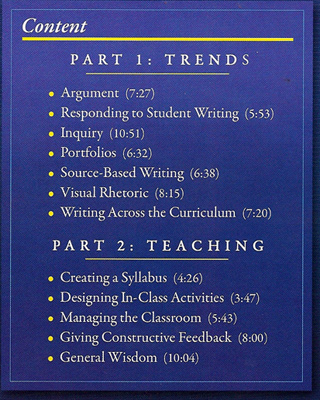Overview
Pedagogy
The DVD’s purpose is to help teachers (especially new teachers) become better teachers, and therefore the chapters on the DVD are divided into two parts: “Trends” and “Teaching” in composition. One might expect from the titles that the first section is going to provide a theoretical base for the second, more “practical,” section. Both sections, however, intend to give teachers practical advice and strategies for teaching composition. While we appreciate the abundance of usable material for the classroom, the theoretical backing for teaching strategies was mostly absent.
"Teaching," part two of the DVD, offers some reassuring and prescient counsel—particularly in the “General Wisdom” section—for anxious new instructors who may lack instructional support through more traditional channels. Unlike the first section, "Trends," which is made up of experienced and respected teachers in the field, the second section contains interviews with graduate students. As a group composed of both faculty and graduate students, we feel this is one of the main pedagogical strengths of the DVD. Members of the target audience, ourselves included, are recognized, given voice, and presented as knowledgeable instructors in the field of composition.
However, Part Two is also replete with contradictory suggestions for concrete pedagogical approaches. For example, one scholar recommends substantial marginal commentary on student documents, while another (in Part One) stresses the need to withhold all such marking until the end of the essay. While the pedagogical lessons in Part Two speak more to programs without institutional mentoring, this portion of the DVD seems to necessitate some supplemental form of support.
TechnologyBecause Trends and Teaching in Composition is an interactive DVD, one might anticipate technology-based sections and/or student assignments, but the technology assumed in this medium often disappoints in the content of this section. Pearson’s DVD occasionally discusses newer trends, for example, the “Visual Rhetoric” section suggests the use of web-based images for rhetorical analysis, but the video as a whole overlooks the opportunity to explore or suggest tangible new media pedagogies or assignments. Audience members legitimately seeking new trends in composition may be disappointed or frustrated by this significant oversight and find the titles of these sections misleading. For instance, the titling of “Visual Rhetoric” in “Trends”—coupled with the fact that most of the other sections in “Trends” include many assignments and activities—sets up an expectation for a host of technological or new media assignments. To avoid the disappointment when this section only describes visual arguments and suggests methods for helping students to analyze them, this section might have been more appropriately named “Recognizing and Analyzing Visual Arguments.” Moreover, the video format of this instructional DVD implies Pearson’s value of technology in instruction, but unfortunately, their use of technology does not model the pedagogical potential of this medium in clear or obvious ways. Pearson lost an opportunity to tap into a growing trend in the fields of both composition and rhetoric. |
 |
|---|
Despite the DVD’s shortcomings, Pearson’s use of video interviewing demonstrates the usefulness of combining technology and narrative as a viable method for instruction. By presenting a spectrum of individuals, from well-established composition scholars to new instructors and graduate students, the film puts faces, voices, and physical gestures together with words—elements which cannot be included in the traditional text-based medium. The DVD humanizes the scholars in the fields of composition and rhetoric and thus presents an open and supportive community to audiences. The scholars come across as helpful, sympathetic, and hopeful regarding the teaching of composition.
Rhetoric
Readers of Kairos seeking cutting edge approaches to rhetoric, composition pedagogy, or technology will be disappointed in the content of Trends in Teaching in Composition; the DVD is clearly intended for those who are new to teaching or to writing pedagogy. This intended audience is obvious throughout, as topics—such as argumentation, source-based writing, visual rhetoric, and WAC—are broadly covered rather than deeply, and general advice from experienced pedagogues is privileged over the rigorous scholarship expected in the field’s journals.
The most problematic aspect of Trends and Teaching in Composition is its subtitle, “A Professional Development DVD,” which reveals a gap between the production’s “real” and “intended” audiences. When scrolling through Pearson's webpage, one cannot help but notice the inconsistent reports on the DVD’s intended audience. For example, the webpage claims to be for “experienced teachers looking for fresh ideas” as well as for new composition teachers or those whose training is in literature. This inconsistent description begs the question whether this was simply a tactic to try and reach the largest possible audience. With a more accurate subtitle, Trends and Teaching would make a better appeal to its “real” audience—new teachers of composition—and would thus be a more useful tool in the field of composition.
While Trends in Teaching may not add particularly new perspectives to each of its topics, readers of Kairos who are WPAs or teachers of writing pedagogy might find the DVD’s general overviews and topical organization as useful discussion starters for various aspects of writing pedagogy. Additionally, Trends in Teaching might be helpful to adjuncts, in cases where they have little to no formal training in composition.